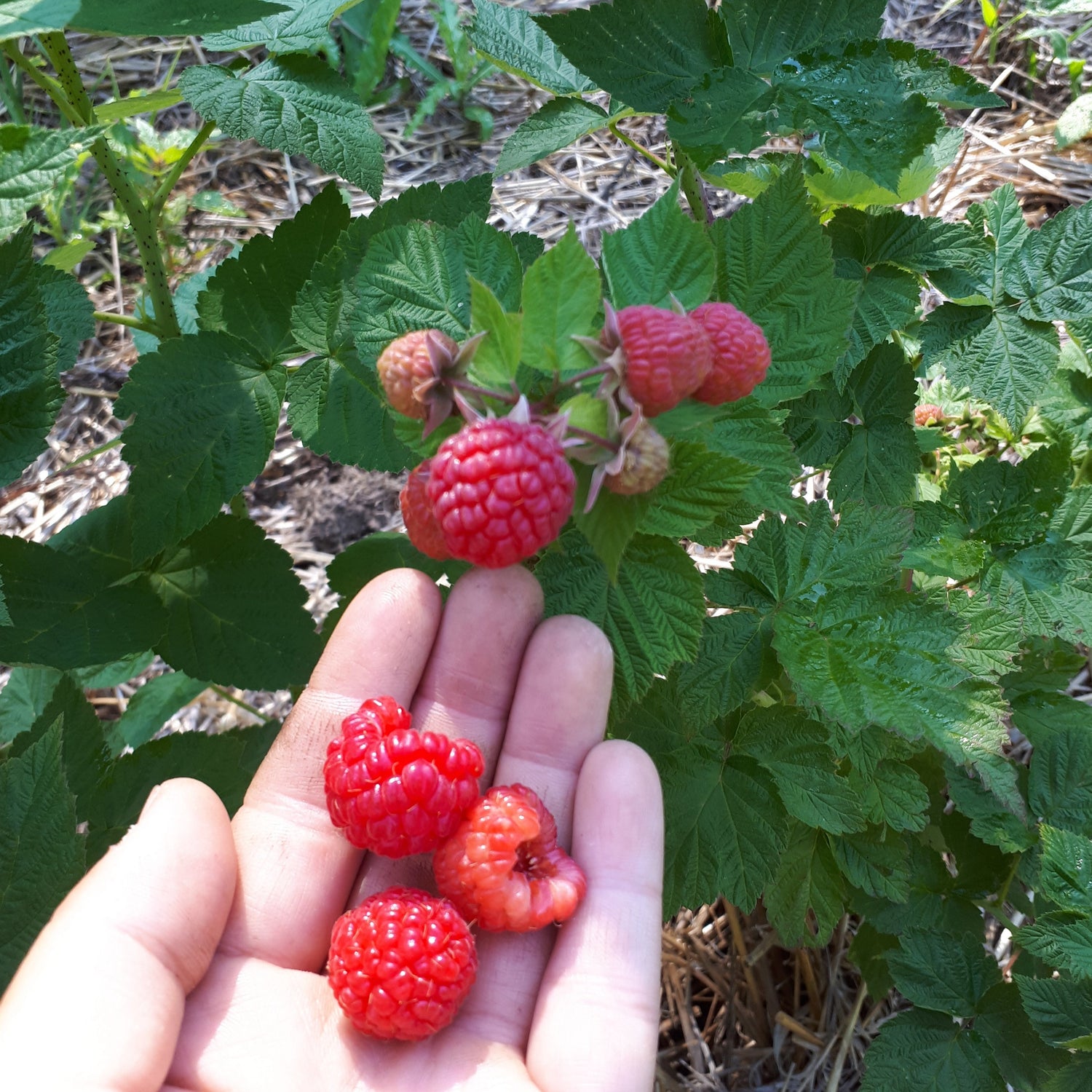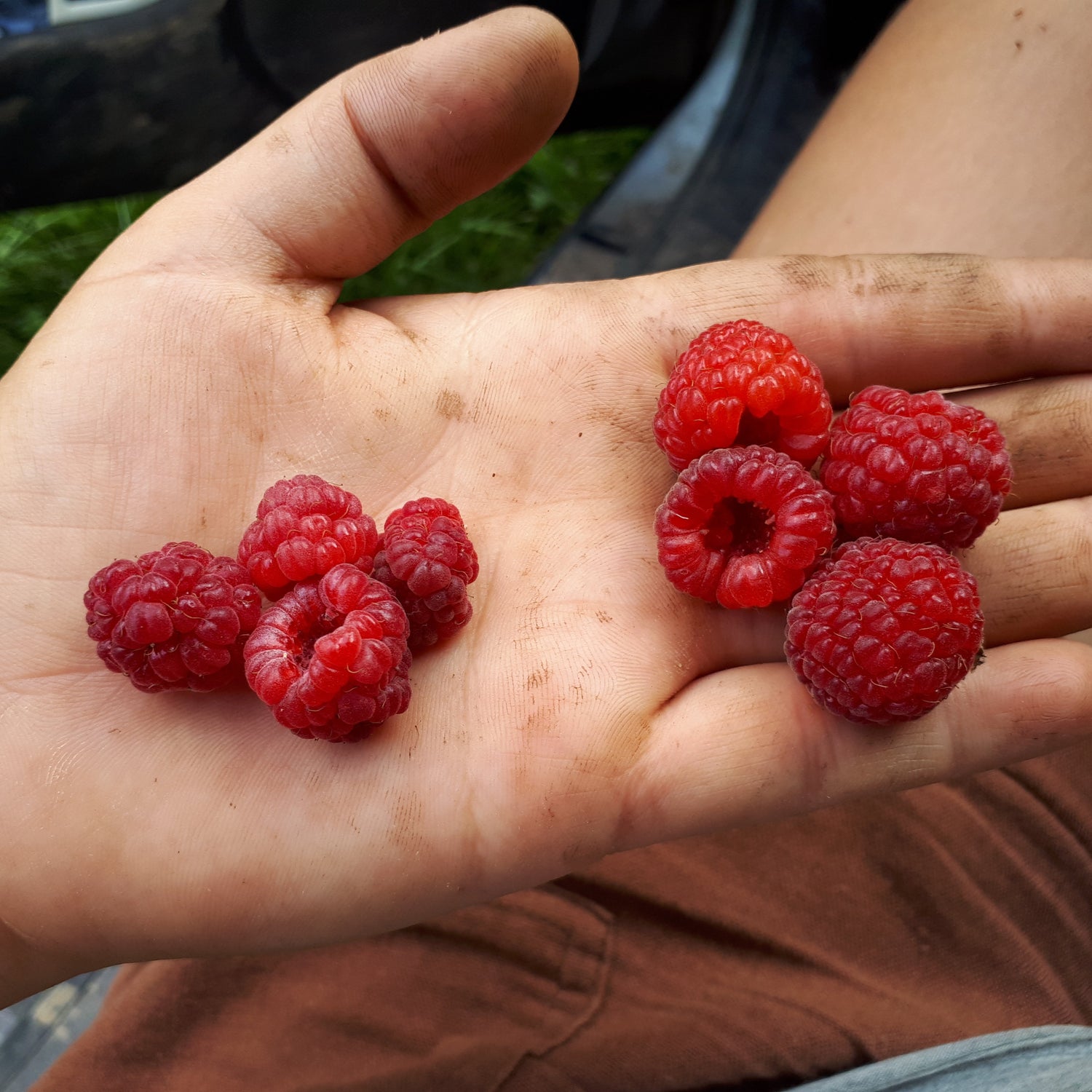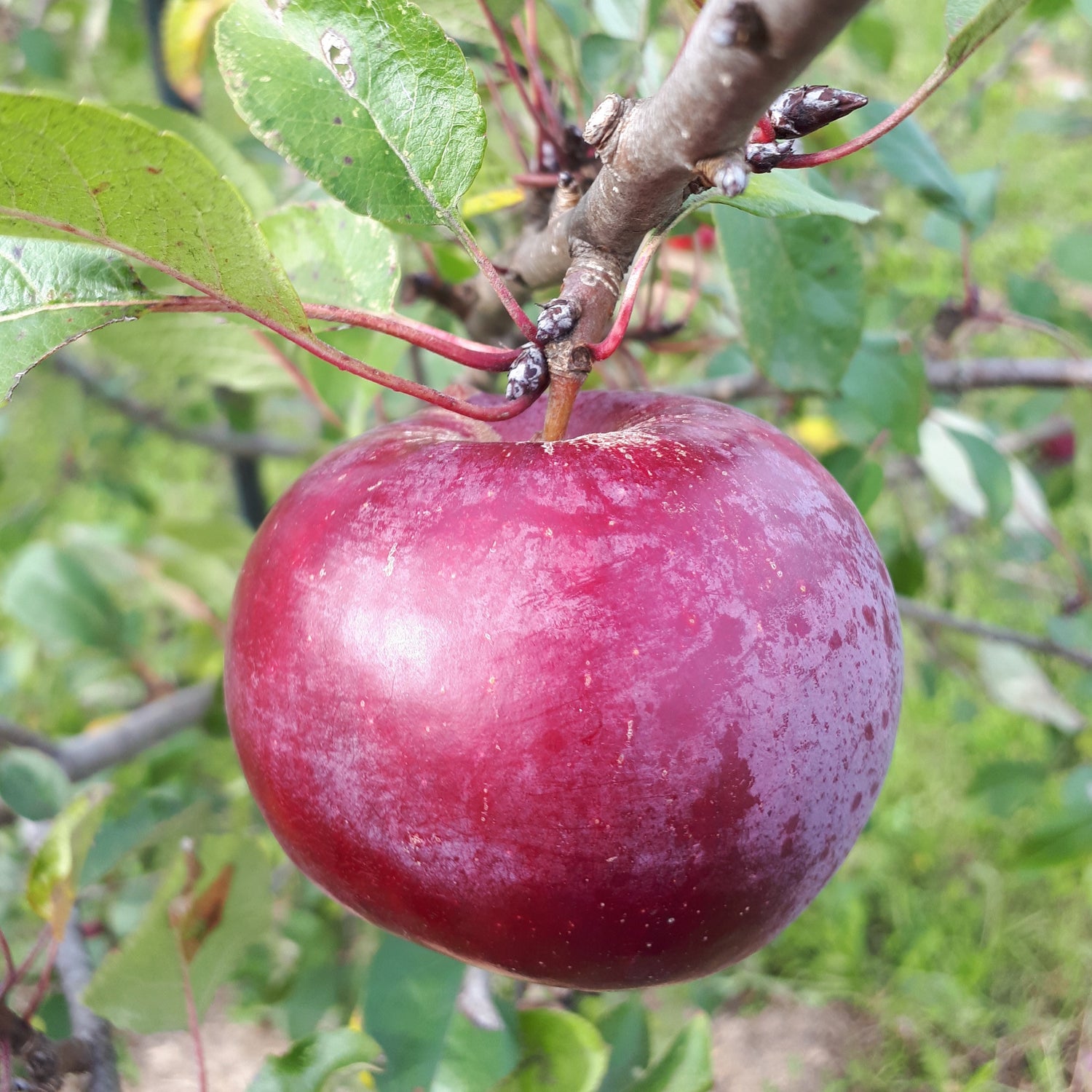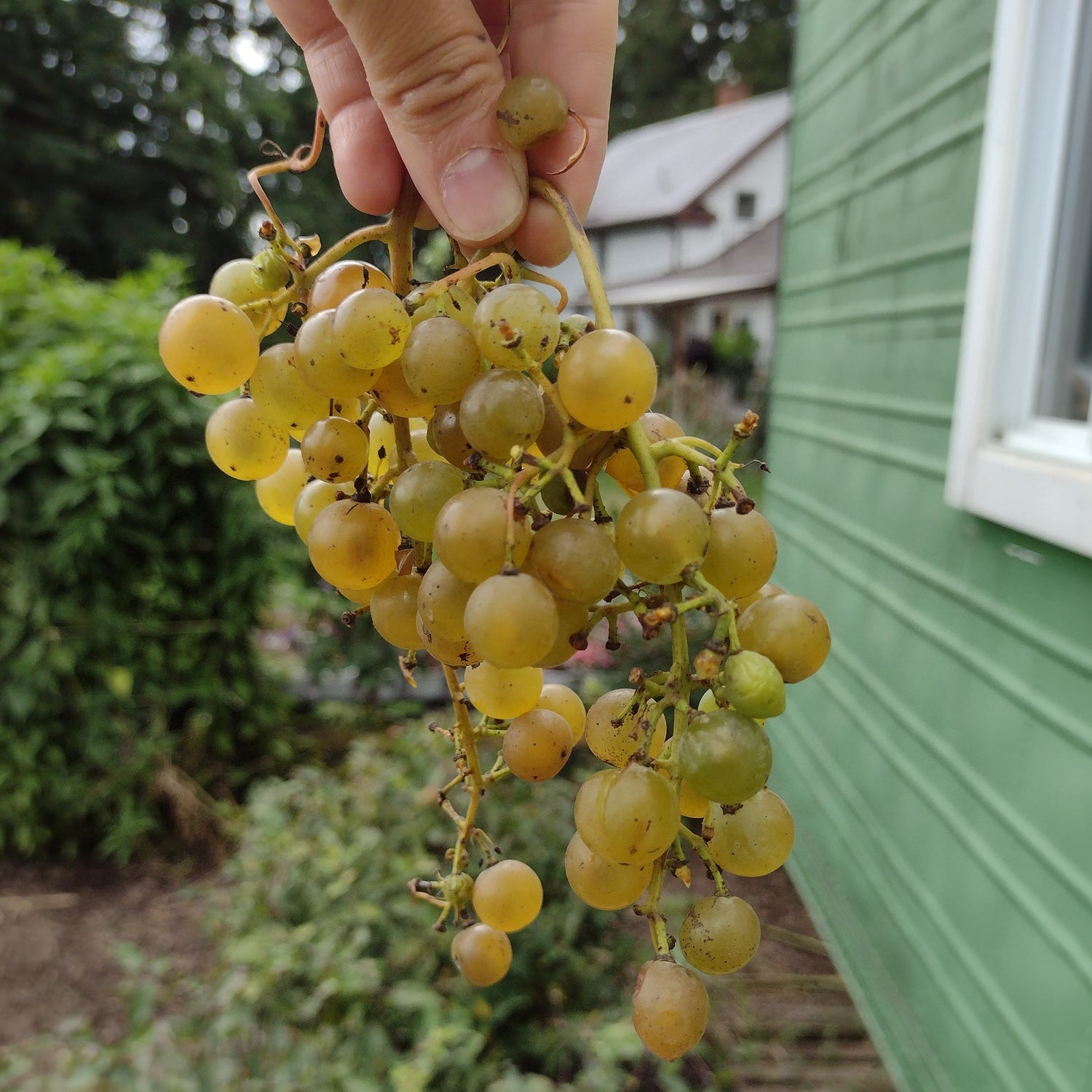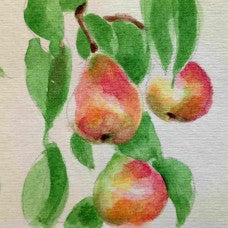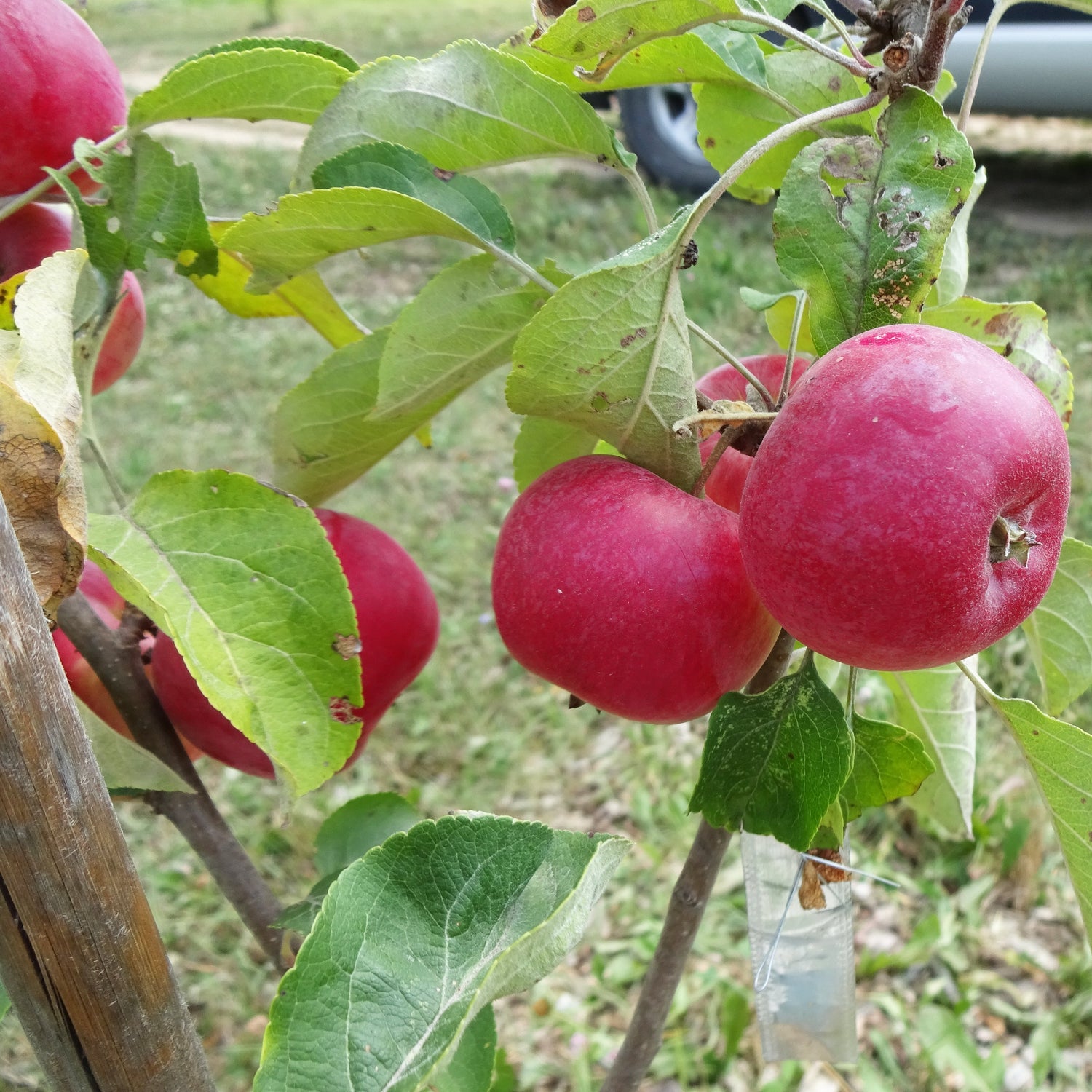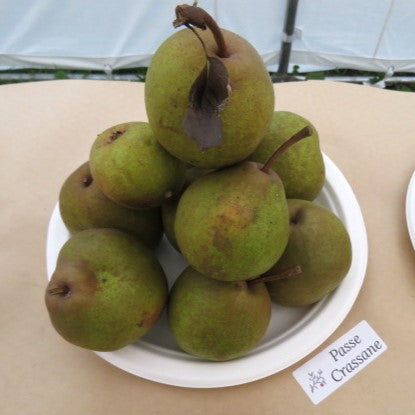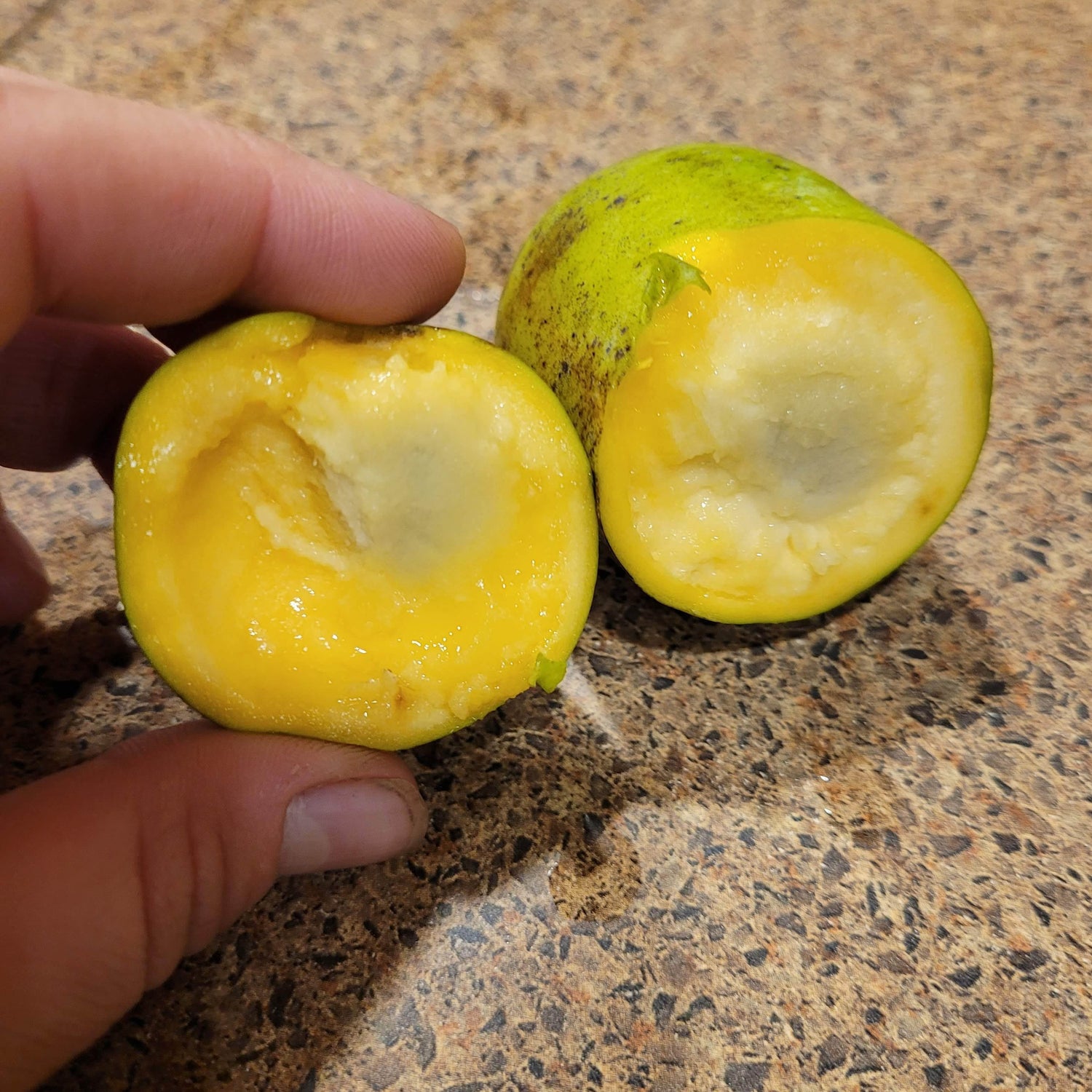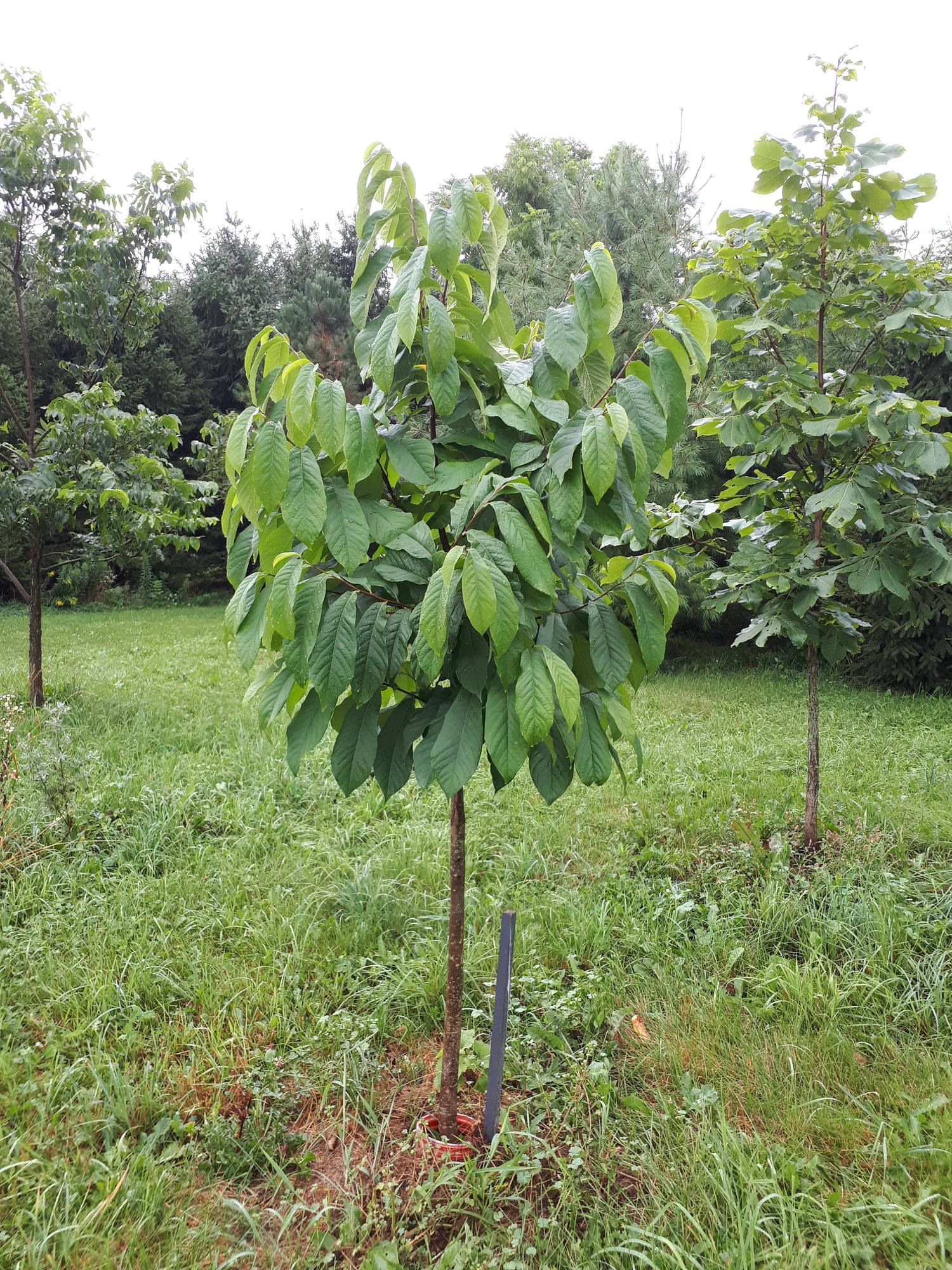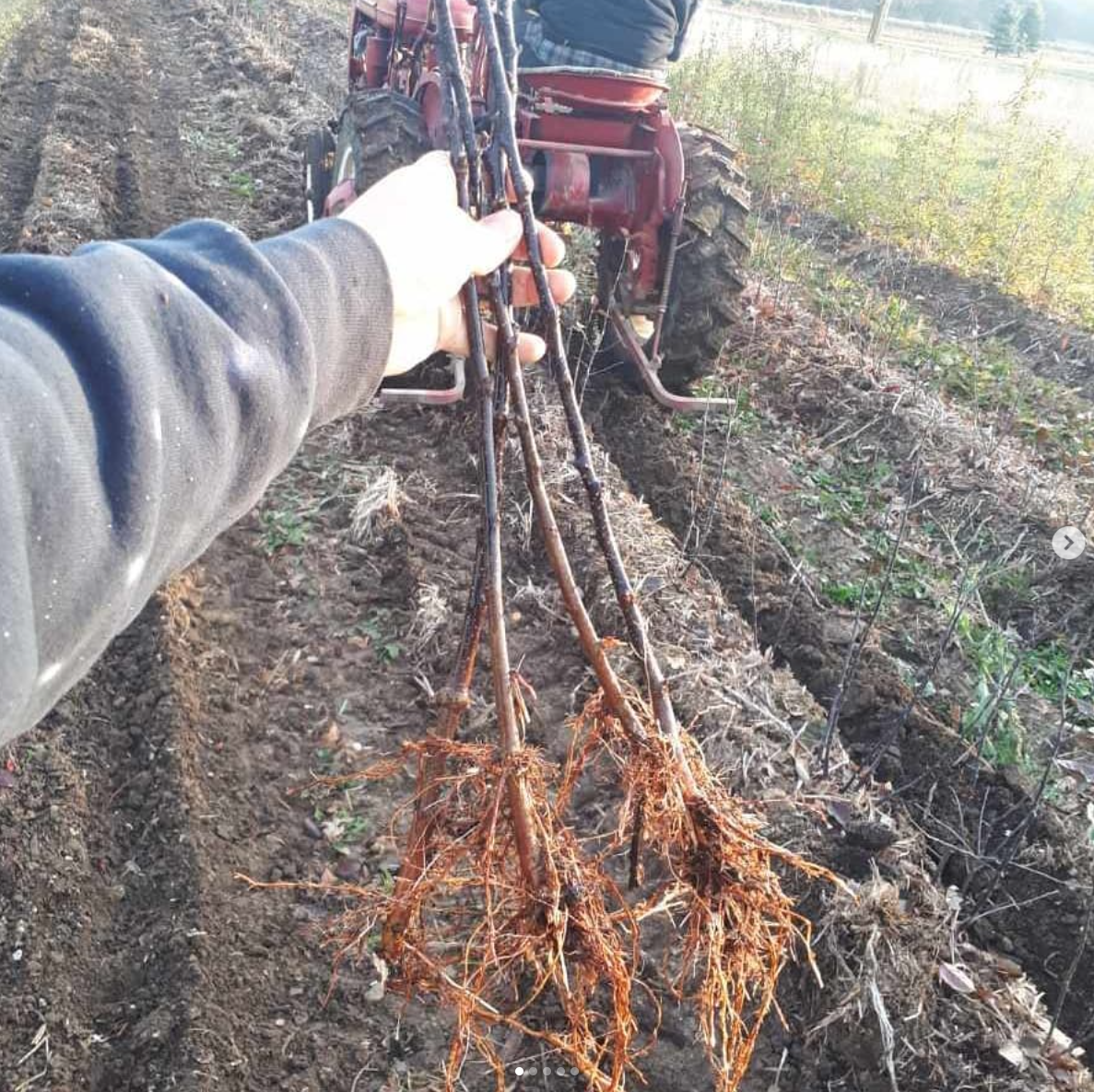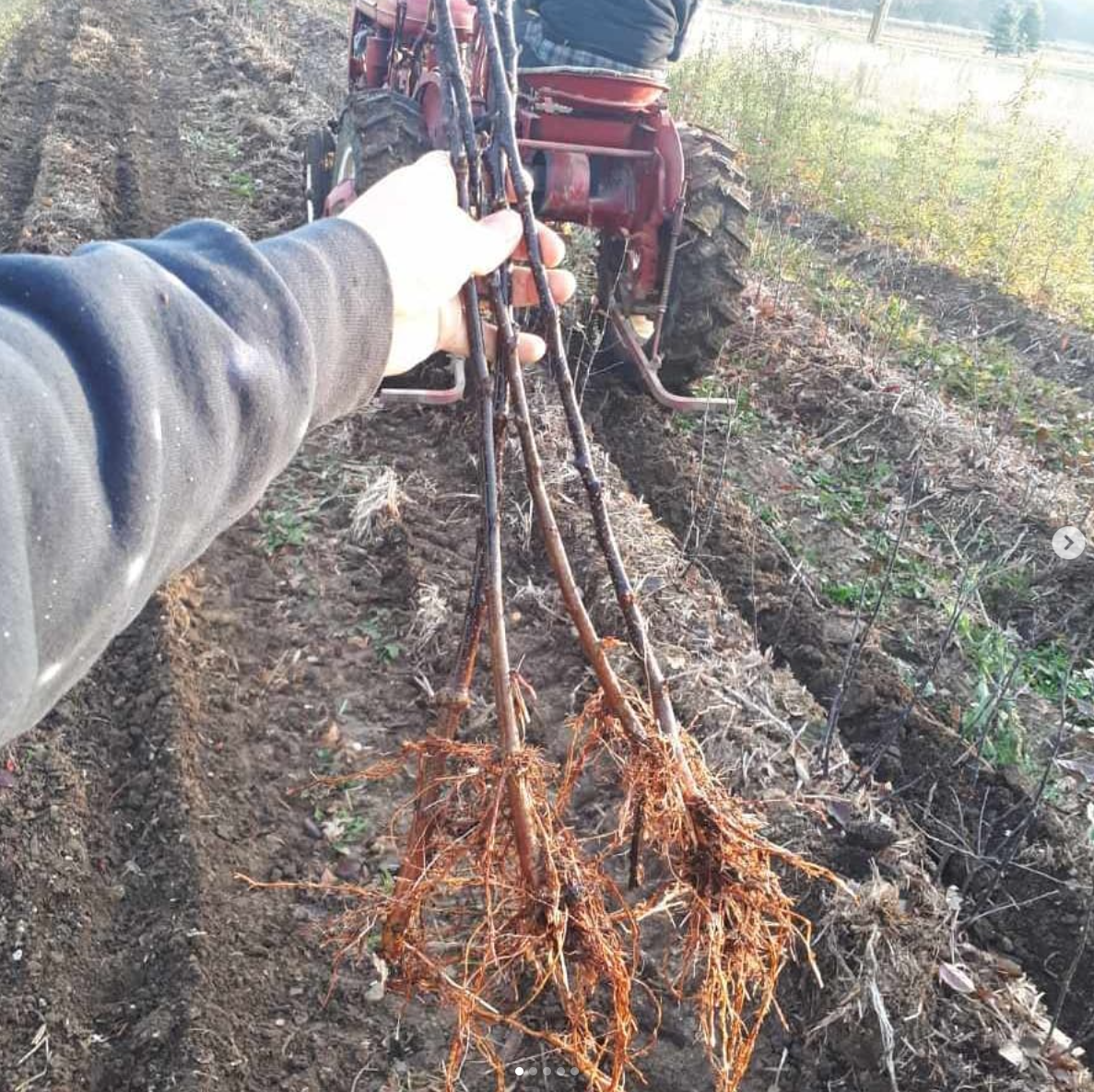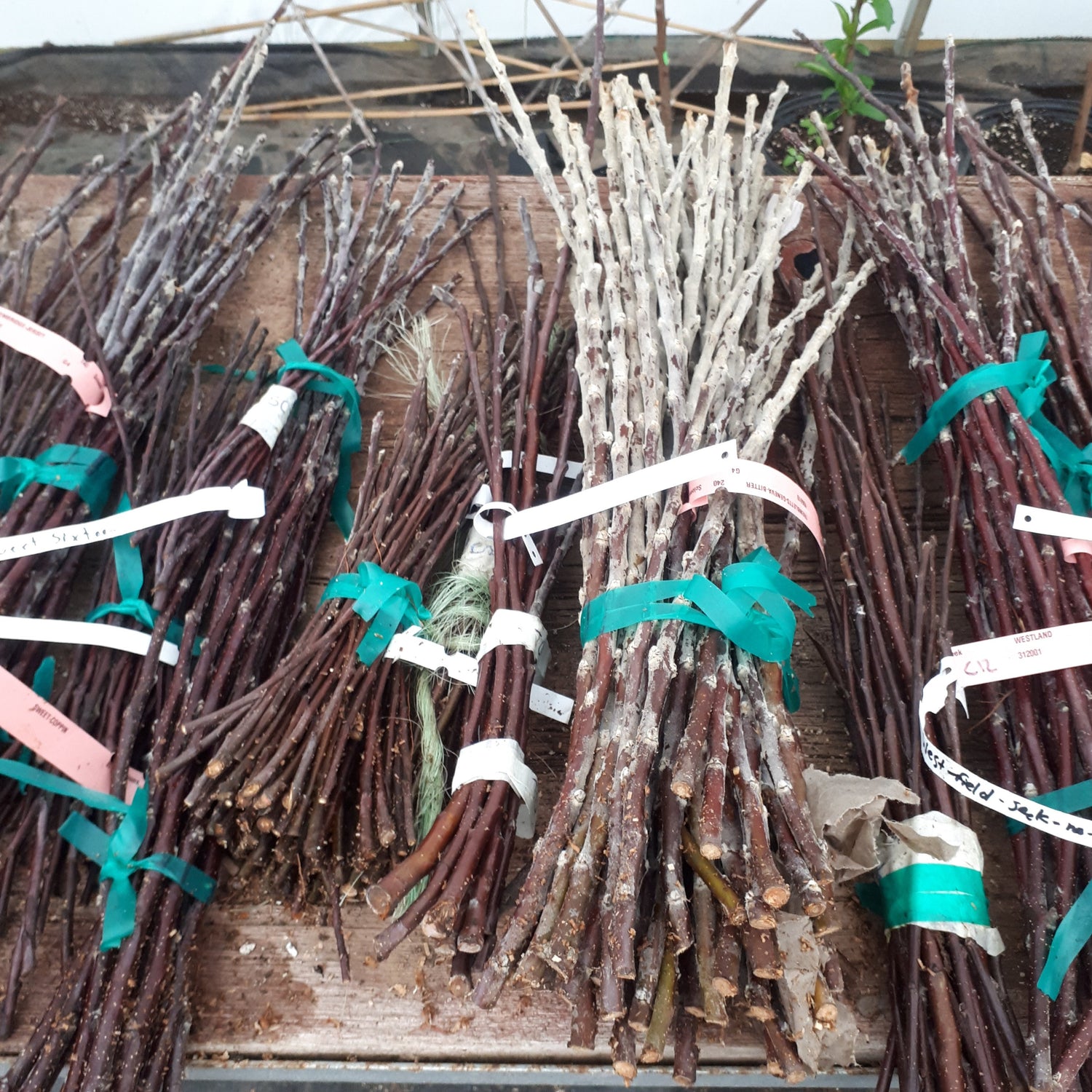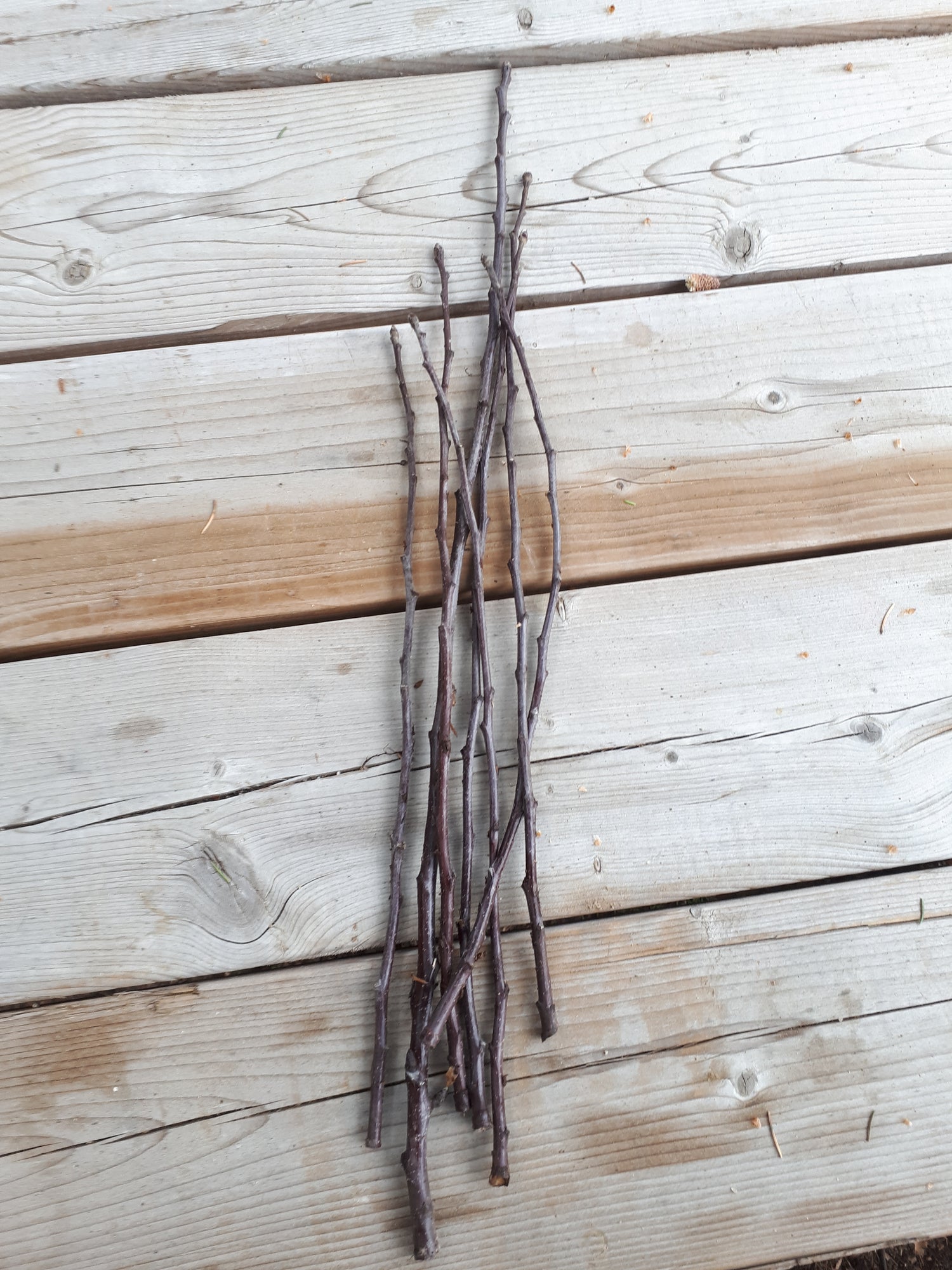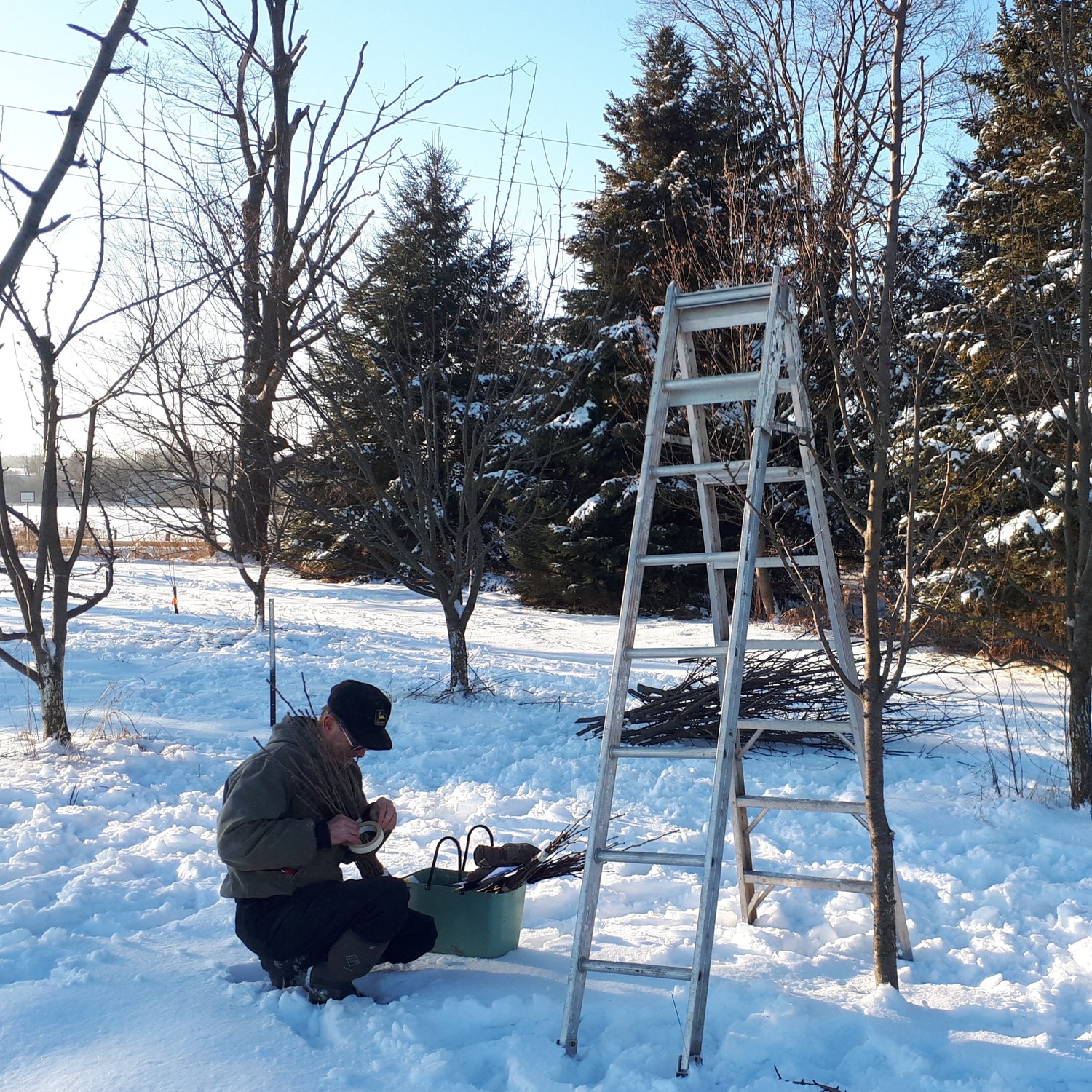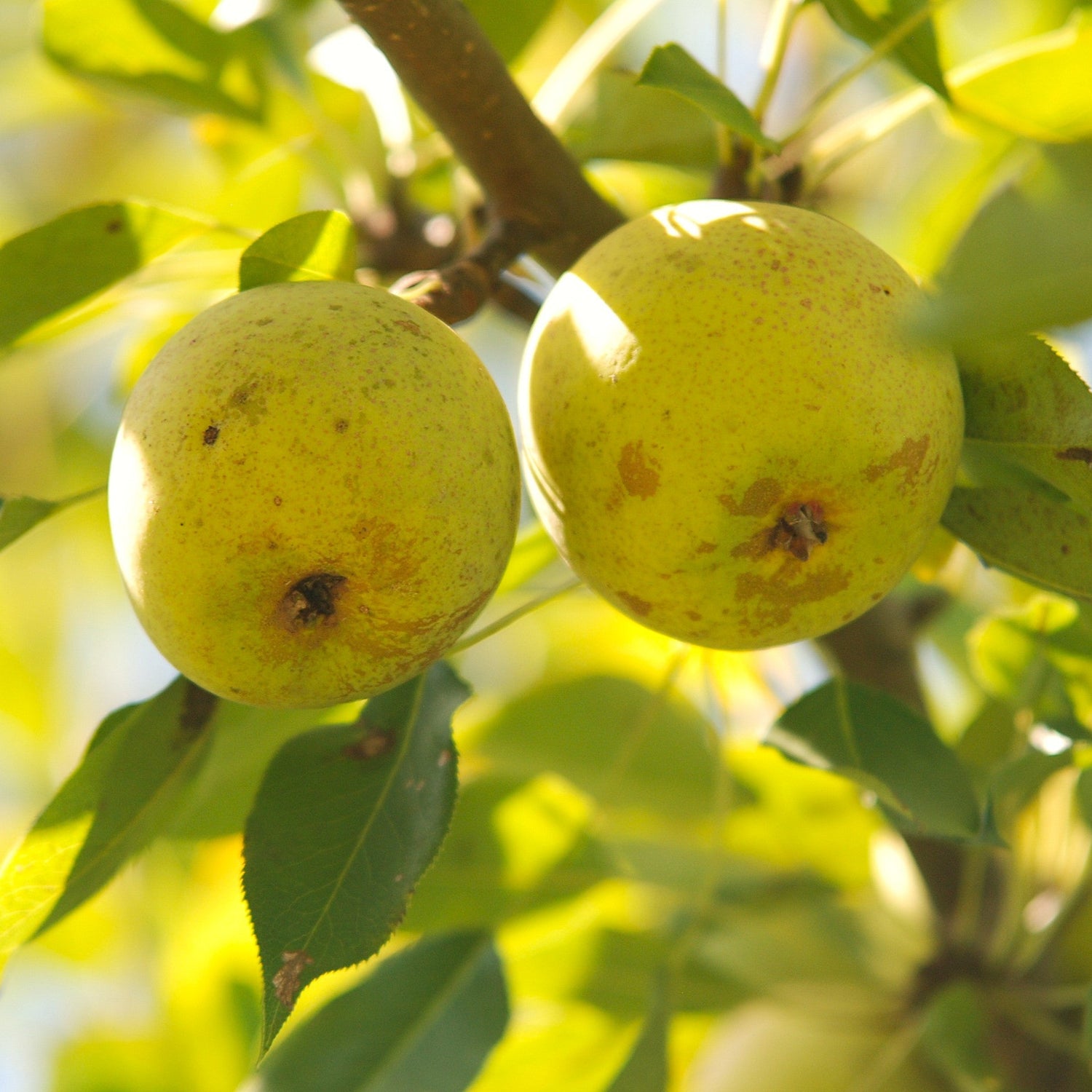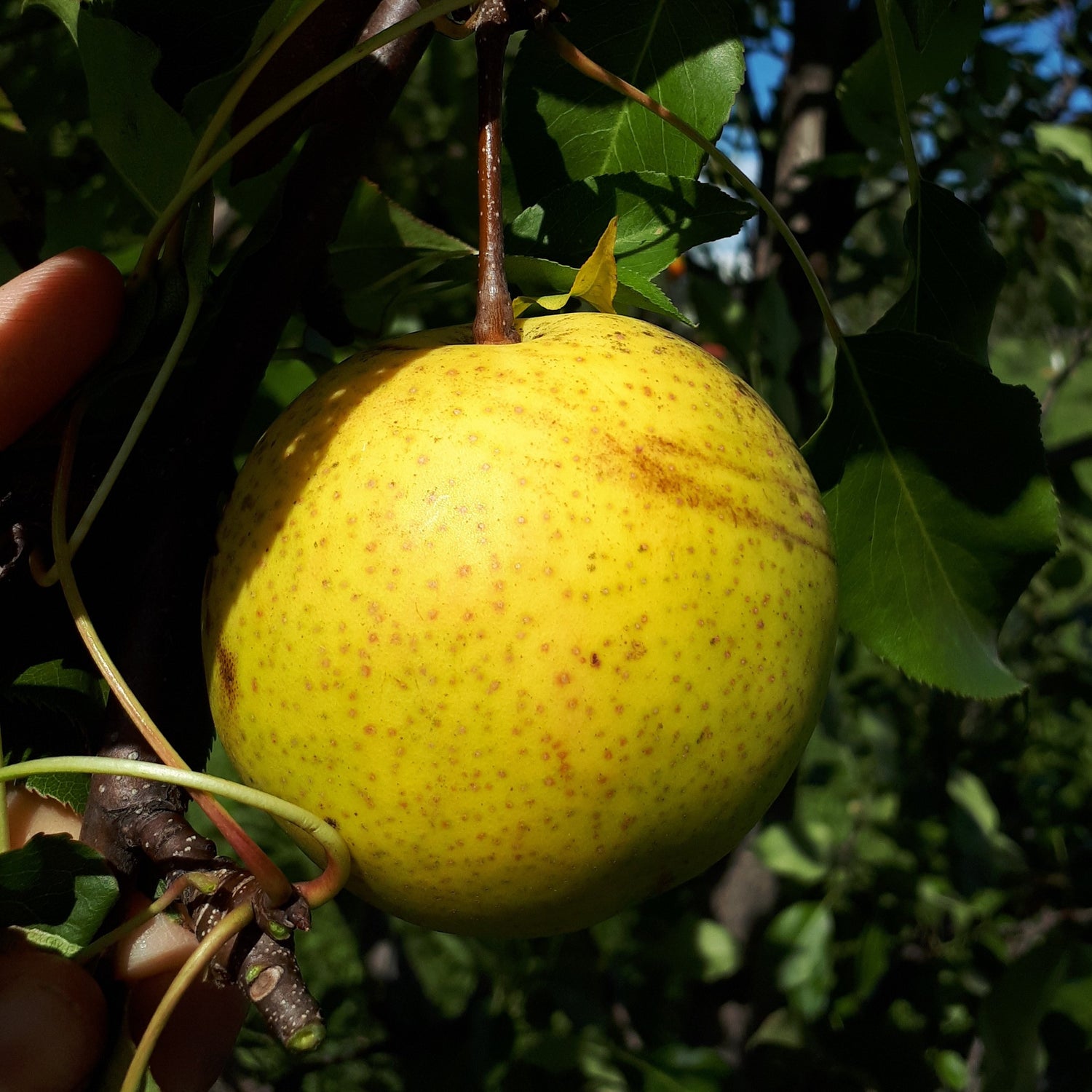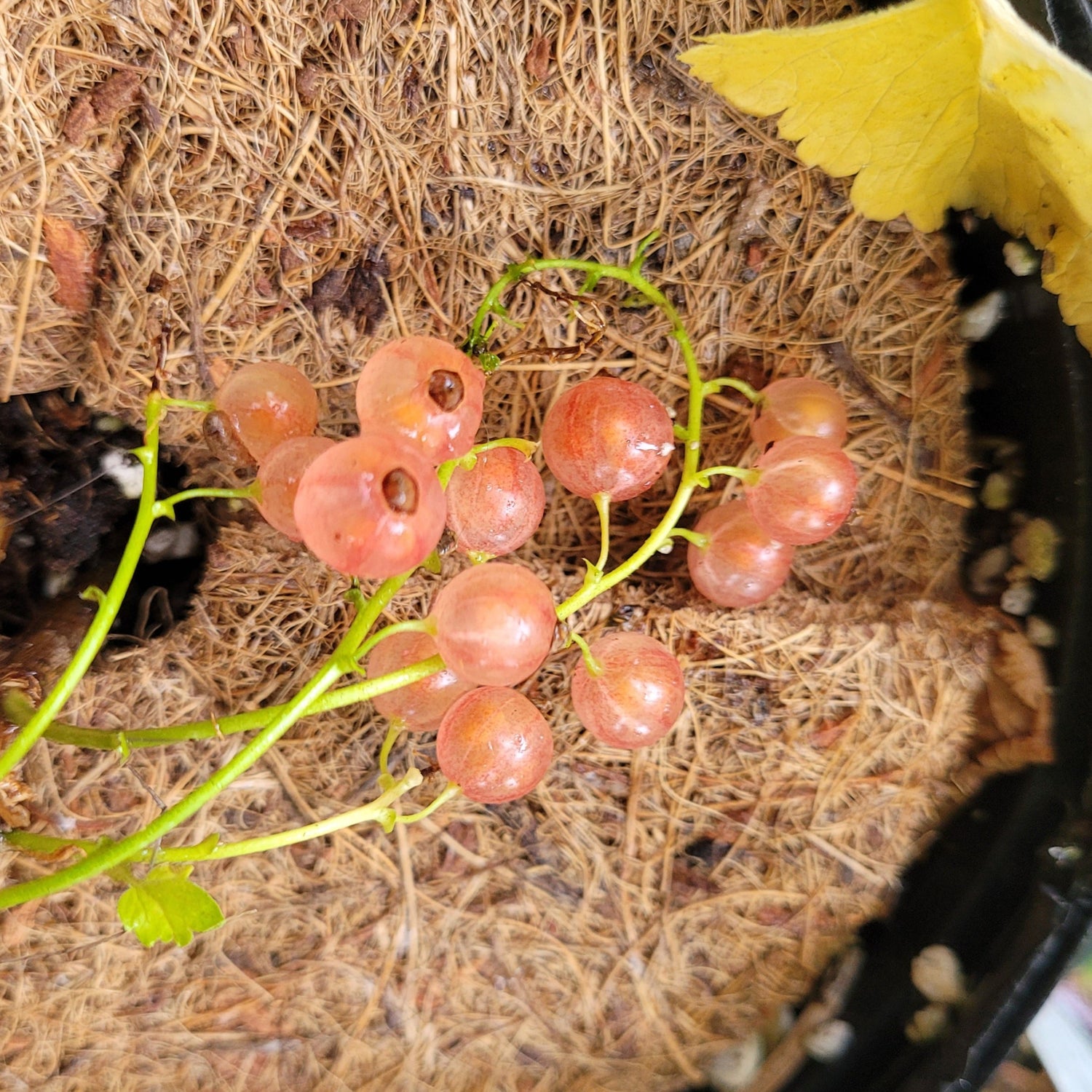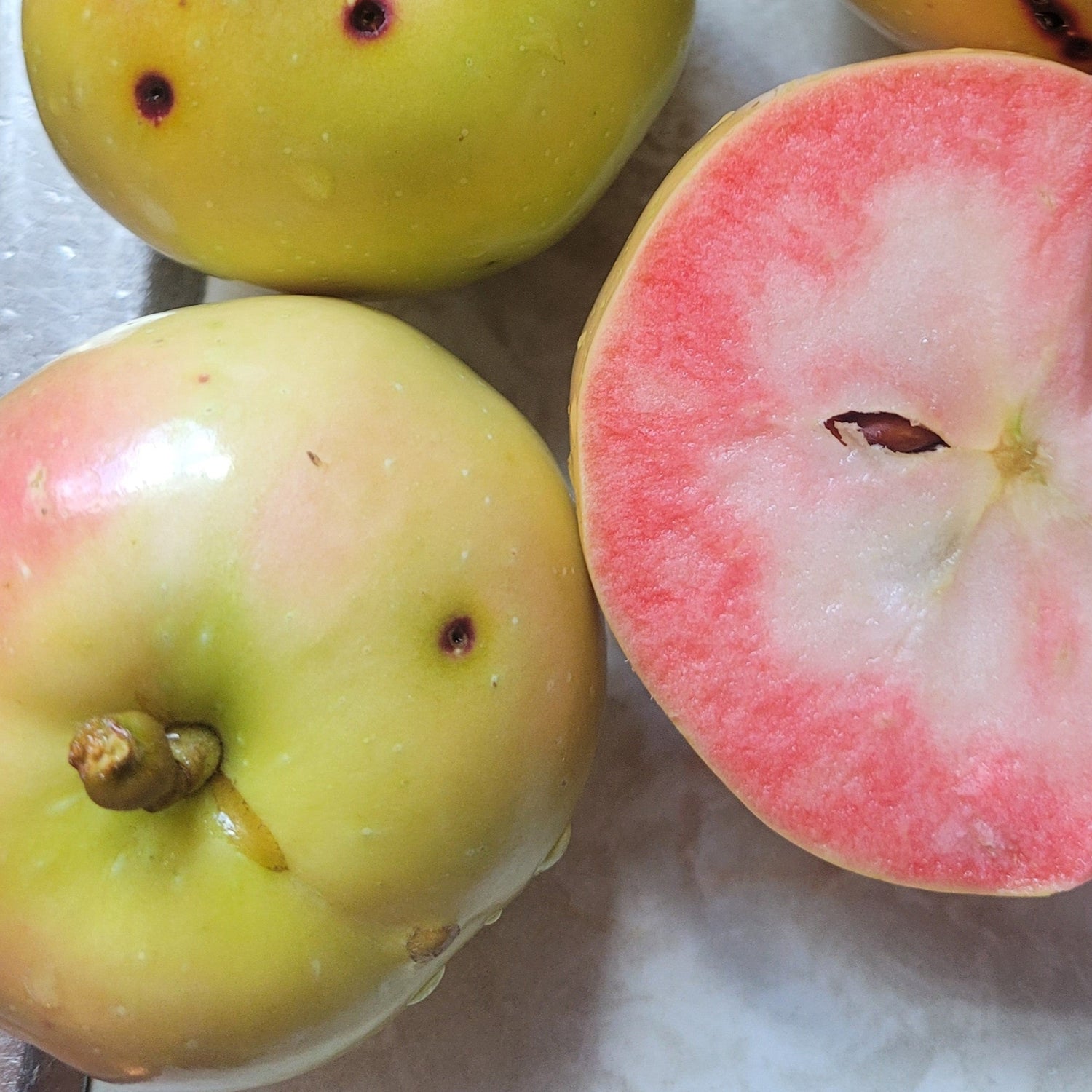Products
Sort by:
475 products
475 products
Species: Rubus sp.
History: Nova red raspberries were developed at the AAFC Research and Development Centre in Kentville, Nova Scotia as part of a breeding program. They were bred as a cross between Southland and Boyne raspberries and released in 1981.
Why We Grow It: These nearly thornless canes bear a plentiful yield of bright red, large-sized berries. The finer textured fruit is less crumbly and has a bold flavour. Nova red raspberries are very hardy and are summer-bearing in colder climates and ever-bearing in warmer ones!
The second product photo shows Nova (right) compared to Heritage (left).
The third photo shows a Heritage and Nova raspberry tart Steph made!
History: Novamac apples were developed at the AAFC Kentville Research and Development Centre in Nova Scotia and introduced in 1978.
Why We Grow It: Novamac is a variety that definitely deserved more attention. They are generally disease resistant and have proven to be very easy to grow in our test orchard where they are performing well. This apple has a nice vibrant tang but also lots of sweetness and notes of berry. The flesh is firmer than its namesake McIntosh, which it is descended from.
Species: Aesculus glabra
History: Ohio Buckeye is native to Walpole Island in Ontario and some central and southern states in the United States. The Shawnee name for the tree is 'hetuck' which means 'eye of the buck' due to the nut's resemblance to a deer's eye. Indigenous peoples such as the Lenape traditionally use the nuts for medicinal uses, tanning leather, and jewellery. Ohio Buckeye is the state tree of Ohio and people from Ohio and graduates of Ohio State University are sometimes called 'buckeyes'. Unsurprisingly, the nuts have an important cultural place in Ohio. There is a candy resembling the nuts called 'buckeyes' that are popular and the nuts make numerous appearances in Calvin and Hobbes whose author is from Ohio. Its wood is too soft to be used for much and it has limited uses as a street tree since it is considered messy due to the nuts it drops.
Why We Grow It: Ohio Buckeye is an attractive ornamental tree with its large, palmate leaves and notable yellow flowers in spring. Although the tree is toxic and generally not fed on by wildlife, the large flowers are very attractive to a variety of pollinators including hummingbirds!
History: Discovered in Olympia, Washington by Denny McGaughy in 2014, this variety doesn't match any of the 200+ registered varieties in the Department of Agriculture's National Clonal Germplasm Repository, making Olympian figs true age unknown, and quite possibly heirloom despite its recent popularity.
Why We Grow It: Large purple-red figs have excellent flavour, reminiscent of peaches! Very vigorous and productive, producing a strong breba crop on the pervious seasons growth.
Sample your way through 15 unique varieties of apples, pears and various other fruits, all of which are grown organically in our test orchards, and none of which you would find at the grocery store!
We will focus each box on what is ripe, abundant, and uncommon, that you might explore the wilder side of the harvest! As ripening dates vary from year to year, we cannot offer a predetermined list of what will be in each box, but we do hope to include the likes of sea buckthorn berries, pawpaw, blackberries, plums, sunchokes, various nuts, fresh raw honeycomb and more as the harvest provides.
Boxes must be ordered at least 3 days ahead of the pick-up date so we can be organized, and availability is limited so get your order in ASAP!
Early September: Saturday Sept 6th
Late September: Saturday Sept 27th
Mid October: Saturday Oct 18th
Each box will be a different surprise, bursting with a variety of flavours, smells, textures and colours. Just a reminder we manage the orchard in ‘minimalist organic’ method, and some of our fruit may have some minor pest damage.
Included will be a little pamphlet on the orchard and our farm, and suggested food pairings for your tasting.
Shipping vs. Pick up: Orders will be available for pick up on the Saturday dates listed during store hours. Additional fruit may be for sale on these dates at the nursery as available. Orders requiring shipping will be shipped the following Monday to pick-up date. Shipping fees are calculated per order, therefore if more than one box is on an order but shipping on seperate dates, additional fees may apply prior to shipment. We will contact you within a few days of placing the order if this may be the case.
Unsulphured blackstrap molasses are a great way of getting some much-needed nutrients to your trees in a more natural way, generally being considered high in iron, calcium, and magnesium. It is also a key ingredient in our Holistic Spray if you are using effective microbes.
Please note the molasses we carry is not food grade.
Contents: Organic, unsulphured, pasteurized, non-GMO blackstrap molasses
Size: 945mL bottle
Application:
-
Root Drench - 1tsp per 1L of water during vegetative state every 7-14 days
- Root Drench During Bloom - 2tsp per 1L of water every 7-14 days
- Foliar - 1/4tsp of water per 1L of water every 14 days
Soil: Any
Tree Discount: Purchase multiples of this tree & enjoy the savings!
Enjoy our bulk quantity discount (see below) and add to cart to see how much you save!
Species: Maclura pomifera
History: Osage Orange is originally native to a small portion of Texas, Arkansas, and Oklahoma. It was first introduced to European colonizers in the early 1800s by the Osage Nation, hence the name of the tree, who prized it for its use in making bows. It was then widely planted across the US in hedgerows thanks to the dense, thorny hedges it forms when pruned that were impenetrable to livestock. It was in fact one of the primary trees included in President Franklin Roosevelt's Great Plains Shelterbelt project which started in 1934 and by 1942 had resulted in 220 million trees being planted. The hard, rot-resistant, yellow wood was also useful for making fence posts, tool handles, and dye.
Why We Grow It: Although the fruit produced by the Osage Orange is not considered edible, this tree has plenty of other uses! It is still commonly planted as an ornamental tree and the bright yellow inner wood adds an extra level of appeal.
Species: Vitis vinifera x V. rupestris x V. ripraria x V. labrusca
History: Osceola Muscat/ES.8-2-43 was bred by renowned grape breeder Elmer Swenson as part of his effort to mix French and North American grapes to create high-quality varieties that grow well in cooler climates. Osceola Muscat is a cross between four different species: Common grape (Vitis vinifera), Vitis rupestris, Riverbank grape (Vitis riparia) and Fox grape (Vitis labrusca). Swenson bred it on his farm near Osceola, Wisconsin and in 2010 the variety was named after the town. The grape's alternate name, Muscat de Swenson, is named after Swenson himself who passed away in 2004.
Why We Grow It: Osceola Muscat produces loose clusters of seeded, intensely aromatic grapes with notes of peach and apricot. The small-medium, thin skinned fruit is suitable for fresh eating or juice and wine. This is one of the hardiest 'muscat' varieties available and is relatively vigorous.
Species: Hamamelis vernalis
History: Ozark Witch-Hazel is native to the Ozark Plateau in the United States for which it is named. It has been cultivated ornamentally for its strong scent and unique flowering time, blooming from mid/late winter into spring. The name comes form a misspelling of the English word 'wyche' which means 'pliable' and 'hazel' due to the shrub resembling hazelnut shrubs. Interestingly, 'water witches' in the area did use Ozark Witch-Hazel branches in their water-finding rituals to divine the best locations to dig wells.
Why We Grow It: Witch-hazels are a unique plant for any property, sprouting stringy yellow flowers in the winter when nothing else is flowering. They produce woody capsules that forcibly pop open, launching the hard, black seeds up to 10m away.
We use this in our orchard for all trees (both in our experimental orchard and nursery stock) as part of our holistic spray system. You can download the holistic spray recipe here.
Cold-pressed, live and nutrient-rich, this liquid fish hydrolysate is not sterilized with high heat like an emulsion. 100% no chemicals added, suitable for organic production. Excellent source of probiotics and mycorrhizae that aid the roots in nutrient and water absorption, and for earthworms that increase organic matter in the soil.
Bottle contains 1L. Enough to make 50L of spray mix.
History: Packham's Triumph were created by Charles Packham in 1896 in the town of Molong, located in Australia. His goal was to create a late-ripening pear and this popular pear proves he was indeed triumphant. This pear is most commonly grown in the southern hemisphere and the town of Molong is quite proud that such a beloved variety is part of their history.
Why We Grow It: Packham's Triumph is bright-yellow with russet mottling and smooth, white, juicy flesh that has an excellent flavour and smooth texture. The tree produces heavy and reliable crops.
History: Parkland apples were variety created at the Morden Research and Development Centre in Manitoba and released in 1979. Like other varieties developed there, Parkland was designed to withstand the harsh prairie winters and is especially cold hardy. It has become the most commonly grown apple in Alaska after it was brought over in 1985 in an effort to determine which Canadian varieties could survive in the northern state.
Why We Grow It: Parkland is a very satisfying early season apple - sweet and crunchy. It's excellent snacking or applesauce although the fruit is small (about 2" diameter) with creamy flesh and red skin. The tree is quite hardy.
History: The Passe Crassane pear originated in France where it was grown by Louis Boisbunel in 1845 and first bore fruit in 1855. It quickly became popular and was grown in France, Italy, and Spain and commonly exported to Germany and England. The stems were sealed with a red wax to keep in moisture during the pear's long ripening period which became a symbol of the variety. Although its susceptibility to blight has caused its popularity to decline since then, it is still grown on a small scale in parts of France and Italy.
Why We Grow It: This French winter pear is aromatic, floral, and fruity with a melting texture. It is best enjoyed after 4-5 months in storage, usually around February to March. Although the tree is hardy, it is susceptible to mildew and fireblight.
Species: Vaccinium corymbosum
History: Patriot was developed by the USDA and Maine Agriculture Experimental Station where it was first bred in 1954. It was selected for its cold hardiness and resistance to root rot. Patriot was released in 1976 and given its name to mark the 200th anniversary of the signing of the Declaration of Independence.
Why We Grow It: Patriot produces large berries with excellent flavour that are a bit on the softer side. The fruit ripens early in the season and is great for fresh eating, baking, preserving, and freezing! It is more tolerant of the cold and of wet soils than other blueberries and can be grown even in a clay soil.
History: Paula Red (sometimes written Paulared) was discovered in Michigan in 1960 by Lewis Arends near a ravine where apples were dumped. It was one of several wild apple seedlings that had sprouted up from the discarded seeds. Likely pleased by its attractive red skin and flavour, Arends named it 'Paula Red' in honour of his wife Pauline. It is a cross between Duchess and McIntosh.
Why We Grow It: Paula Red produces medium to large red apples with small yellow/green patches that are juicy and firm with a nice sweet/tart flavour. The flavour has strong vinous and strawberry notes. It is also slower to brown. This early-ripening variety tends to soften relatively quickly which means it does not store very long, but it is great for making applesauce. The tree produces heavy crops although tends to bear every other year as a result.
Species: Asimina triloba
History: Native to southern Ontario where it is considered a vulnerable species and the central United States, it is believed the range of these trees has shrunk with the extinction of megafauna that likely dispersed the seeds. These oddly tropical fruits have been cultivated by indigenous peoples and European colonizers alike, it is rumoured chilled pawpaw was George Washington's favourite dessert and Thomas Jefferson planted some at Monticello. Although popular among locals and with foragers, pawpaws have failed to achieve any kind of commercial success due to their poor keeping ability and oft difficult pollination.
Why We Grow It: The Pawpaw produces very unique fruit that has a distinct tropical banana/mango flavour and custard-like texture. As it oxidizes fairly quickly once cut open, it is best eaten fresh once fully ripe or made into sauces, ice cream, etc. You can bake and cook with pawpaw like you would with bananas but please take note that some people have reported extreme tummy troubles after consuming cooked pawpaws! Mouse made a no-bake pawpaw cheesecake (pictured on the left), you can find the recipe on our blog here! Pawpaws have a very slow growth habit and grow naturally as an under story tree, usually not reaching over 35 feet. We grow them from seed for increased hardiness compared to grafted stock.
Pawpaws is the first in-depth guide to small-scale commercial cultivation of pawpaws. Also known as Indiana bananas or hipster bananas, this almost forgotten fruit, native to North America, is making a huge comeback with foodies, chefs, craft brewers, and discerning fruit-lovers.
Written by, and for, the organic grower, coverage includes:
- Botany and the cultural history of pawpaws
- Orchard siting and planning
- Choosing the best-quality nursery trees
- Descriptions of over 50 cultivars
- Propagation and organic growing tips
- Pests and disease management
- Marketing and selling fresh pawpaws, seeds, and starts
- Processing and producing value-added products.
Get ahead of the farming curve, diversify your orchard or food forest, and discover the commercial potential of America's almost forgotten native fruit with this comprehensive manual to small-scale commercial pawpaw production.
Peach rootstock availability for Spring 2026 should be updated within the next few weeks!
Please Note: We will be receiving peach rootstock that is non-dormant and grown in ellepots. The rootstock will be too small for grafting the spring that you receive them and should be planted out instead. They may size up enough for summer grafting and would be suitable for grafting the following spring (provided no issues with growth conditions). Shipping fees may be adjusted in the spring since ellepots are more difficult to ship than our bareroot stock.
Looking to graft your own peach trees? We're happy to offer rootstock!
While we have young stool beds growing, in the meantime we import rootstock from Oregon. Aside from the headache (paperwork) of importing and distance, we are very happy with our supplier's quality, and are happy to offer small scale and backyard operations with rootstock. Every August, we prepare a rootstock order for the following spring, and our order comes up on the pool truck with all the other Ontario orders. Because of this, we aren't able to guarantee ship dates with rootstock orders, as we are at the mercy of the nursery and pool truck; the shipment typically comes in March-April.
If you require more than 1000 rootstocks, we recommend importing it yourself.
We offer the following rootstock varieties:
Krymsk 86 - Full-size:
- History: Krymsk 86 is a hybrid rootstock that is a cross between a peach and a plum, meaning it is compatible with peaches, plums, apricots, and almonds. It was bred at the Krymsk Experimental Breeding Station in Russia and is still undergoing many tests in Canada and the US to test its performance.
- Why We Use It: Krymsk 86 is a new but potentially promising rootstock that is compatible with many different Prunus species. It is tolerant of several diseases and some adverse environmental conditions.
- Soil: Loam and sandy loam preferred but some tolerance of heavier soils
- Growth Habits: More vigorous than Bailey, few suckers, develops a strong root system and has some drought and wet tolerance
- Disease Resistance: Tolerant of oak root fungus and less susceptible to crown and root rot than some other varieties
-
Graft Compatibility: Compatible with peaches, plums, apricots, and almonds
Bailey - Semi-Dwarf:
- History: Bailey was released from West Branch, Iowa and for several decades it has been the predominant peach rootstock used in Ontario.
- Why We Use It: Bailey is a reliable and cold hardy rootstock, great characteristics for Canadian growers where the colder climate can make growing peaches much more tricky.
- Growth Habits: Produces medium to large trees that are 90% the size of standard trees, produce reliable and and good-sized crops
- Graft Compatibility: Compatible with most peach varieties grown in Ontario
If you are interested in rootstock for Spring 2026, either email us with your requests or sign up for restock notifications below.
Looking to graft your own pear trees? We're happy to offer rootstock!
While we have young stool beds growing, in the meantime we import rootstock from Oregon. Aside from the headache (paperwork) of importing and distance, we are very happy with our suppliers quality, and are happy to offer small scale and backyard operations with rootstock. Every August, we prepare a rootstock order for the following spring, and our order comes up on the pool truck with all the other Ontario orders. Because of this, we aren't able to guarantee ship dates with rootstock orders, as we are at the mercy of the nursery and pool truck; the shipment typically comes in March-April.
If you require more than 1000 rootstocks, we recommend importing yourself.
We offer the following rootstock varieties:
Provence Quince - Dwarf (see the quince rootstock listing HERE to purchase)
- History: Provence Quince is a quince rootstock that was selected by the Institute National de la Recherche Agronomique's Angers station in France. It was released in the 1960s and became especially popular in Europe in the 1980s and 1990s.
- Why We Use It: Provence Quince is easy to propagate and has decent vigour. Although it is incompatible with certain pear varieties, the issue can be overcome with the use of an interstem.
- Canadian Hardiness Zone: 5
- Growth Habits: Dwarfing affect on pears, reaches about 10-15ft tall, precocious, produces good crops
- Disease Resistance: Resistant to crown gall, pear decline, and nematodes but somewhat susceptible to fireblight
- Graft Compatibility: Compatible with most European pears including Anjou, Flemish Beauty, and Summercrisp. Incompatible with Bartlett, Bosc, Seckel and a few others, we use an Old Home interstem to graft these varieties to Provence Quince. Also compatible with quince and loquats.
OHxF 87 - Semi-Dwarf
- History: Old Home x Farmingdale 87 is part of the OHxF series that was developed by F.E. Reimer at Oregon State University in an effort to create fireblight resistant rootstock. Two fireblight resistant varieties, Old Home and Farmingdale, were bred to pass the resistance on to their seedlings, hence the name. OHxF 87 in particular was selected for its good productivity.
- Why We Use It: A popular choice among the OHxF series, this semi-dwarf rootstock boasts high productivity and a good root system.
- Canadian Hardiness Zone: 4
- Growth Habits: Semi-dwarf, reaches 12-18ft, precocious and very productive, cold hardy, produces a good root system
- Disease Resistance: Resistant to fireblight and soil diseases
- Graft Compatibility: Compatible with European pears and Asian pears, though some resources say Asian pears tend not to live as long on this rootstock.
OHxF 97 - Full Size
- History: Old Home x Farmingdale 97 is part of the OHxF series that was developed by F.E. Reimer at Oregon State University in an effort to create fireblight resistant rootstock. Two fireblight resistant varieties, Old Home and Farmingdale, were bred to pass the resistance on to their seedlings, hence the name.
- Why We Use It: OHxF 97 is our go-to pear rootstock with its fireblight resistance, strong root system, and good vigour and productivity. Its compatibility with European and Asian pears makes it extra versatile, a feature we value with our large array of pear varieties.
- Canadian Hardiness Zone: 4
- Growth Habits: Full-size, reaches 16-20ft, cold hardy, strong root system, produces good crops, vigorous, moderately precocious
- Disease Resistance: Resistant to pear decline and fireblight
- Graft Compatibility: Compatible with all European and Asian pears
Pyrus betulifolia - Full Size
- History: Pyrus betulifolia (aka birchleaf pear) is native to parts of China and Tibet. This thorny cousin of the pear trees we grow is commonly used as rootstock for Asian pears.
- Why We Use It: Pyrus betulifolia is a vigorous and adaptable pear rootstock, compatible with both European and Asian pears. It is also a very thorny variety, making it useful for deterring critter damage on the rootstock.
- Canadian Hardiness Zone: 4
- Growth Habits: Full-size, produces Asian pears 15-20ft tall and European pears over 30ft, vigorous, highly adaptable to different soils, very thorny
- Disease Resistance: Resistant to fireblight and pear decline
- Graft Compatibility: Compatible with European pears and Asian pears
If any varieties you are interested in have sold out, contact us to be added to our Spring 2026 request list!
If you are interested in scionwood for Spring 2026, either email us with your requests or sign up for restock notifications below.
For those looking to graft heritage and unique pear trees, we are happy to provide scionwood directly from our orchards! We offer a wide selection which will be listed further below, divided into Asian and European varieties. Descriptions for most varieties can be found on our website and in our catalogue!
ORDERING & SHIPPING SCION: Orders must be placed by January 31st, 2026 for the Spring 2025 season and we require a minimum 25% deposit upfront. We will be shipping all scion orders in the 2nd week of April; for those who order both scion and rootstock/plants, your scion will ship with your other products when all items are ready.
Due again to the nature of nature, sometimes scions begin budding out early and we want to ensure you receive dormant scionwood that you will have time to graft with. If you need to hold your scionwood dormant until May, you will need to decide how you will do that. It is relatively simple, and you can learn more about storing scionwood at home here. If you are picking up your scion order, we recommend doing so ASAP after you receive your pickup notification via email.
Size: 12-18" or 30cm+, as available*. If a scion is less than 6" or 15cm, it will be discounted accordingly.
*Since we specialize in so many varieties, they each have a unique growth habit and vigor. Some cultivars will produce long relatively thick scions, and others tend to produce shorter, thin scions (see photos to the left). We will provide the best quality we can, within natural restraints.
Pictured to the left, some of our scionwood and Wayne bundling and labeling pear scions.
In this DVD—a culmination of workshops recorded in Mexico, Florida, and Massachusetts—plant specialist Eric Toensmeier introduces gardeners to more than 100 species of little-known, underappreciated plants. Ranging beyond the usual suspects (asparagus, rhubarb, and artichoke) to include such delights as ground cherry, ramps, air potatoes, the fragrant spring tree, and the much-sought-after, antioxidant-rich wolfberry (also known as the goji berry), Toensmeier explains how to raise, tend, harvest, and cook with plants that yield great crops and culinary satisfaction. Toensmeier also takes viewers on a plant-by-plant tour of his garden in Massachusetts.
Author and plant specialist Eric Toensmeier (Edible Forest Gardens) introduces gardeners to a world of little-known and wholly underappreciated plants. Perennial vegetables are perfect as part of an edible landscape plan or permaculture garden.
Profiling more than 100 species, illustrated with dozens of color photographs and illustrations, and filled with valuable growing tips, recipes, and resources, Perennial Vegetables is a groundbreaking and ground-healing book that will open the eyes of gardeners everywhere to the exciting world of edible perennials.
History: Pine Golden Pippin's exact origins are unknown, but it is quite an old variety that either originated in northern England or in Scotland. It was first formally described by nursery worker Thomas Rivers in A Descriptive Catalogue of Fruit Trees in 1863. In 1875, Robert Hogg claimed that Pine Golden Pippin was one of the best fresh eating apples around in his book The Fruit Manual.
Why We Grow It: Robert Hogg was correct about Pine Golden Pippin! Despite the small size of the fruit, it makes up for it with crisp and juicy fruit with a sweet/sharp flavour that has a hint of pineapple and resin. The fruit is great for fresh eating and can also be used in cider blends. It tends to be slower growing but produces good crops.
History: Ping Guo Li (translated from Mandarin as 'apple pear') was developed by Jilin Sheng in China and likely named for its round, apple-like shape. While its exact age is unknown, this pear is considered to be an old variety.
Why We Grow It: This Asian pear is nothing but sweet and juicy melting goodness! Its flavour is quite sweet and is comparable to that of a European pear. So far it has performed very well in our test orchard and displays good cold-hardiness.
2025 Staff Favourite
Pink Champagne Currants are Amanda's favourite this year! She says these are "beautiful translucent pink currants that taste as lovely as they look!"
All Staff Favourites are 20% off. The Staff Favourite Discount cannot be combined with other quantity discounts.
Species: Ribes rubrum
History: Pink Champagne currants are a cross between red and white currants. Although the exact origin is unclear, this variety was listed in the catalogue of William Prince's nursery in New York as early as the 1800s.
Why We Grow It: Considered to be one of the best fresh eating currants, Pink Champagne produces beautiful translucent pink berries that have a sweet, delicate flavour. They are easy to grow and produce numerous clusters of hanging, pink berries.
History: Not to be confused with Pink Lady, Pink Pearl was developed by breeder Albert Etter who had the goal of creating red-fleshed apple varieties from seedlings of Surprise, a red-flashed variety. In 1940, he partnered with the California Nursery Company to bring some of these varieties to the public. Pink Pearl was selected as the best amongst his seedlings and released in 1945.
Why We Grow It: One of Steph's favourites! Pink Pearl is a delicious apple that is crisp with a pronounced unique fruity flavour and a nice blend of sweetness and sharpness. Its yellow-pink skin conceals a bright pink interior that is stunning to see compared to the white-ish flesh of most apples. It is great fresh or for applesauce, and it is relatively slow browning- it can be cut and bagged in the fridge the night before with very little change in colour the next day. Their pink colour adds a unique visual appeal to baked goods as well, such as with the gooseberry and Pink Pearl tarts Steph made pictured here!
Why We Grow It: Pinova produces lovely yellow fruit with pink to red blush and some striping. It is very flavourful with plenty of sweetness and complexity and a strong floral aroma. This crisp, juicy apple is great for fresh eating, produces bountiful crops, and stores exceptionally well. The tree is also resistant to scab and late spring frosts!
Species: Ribes uva-crispa x Ribes missouriense
History: Pixwell was developed at the North Dakota Experiment Station in a gooseberry breeding program that began in 1920. A cross between Oregon Champion and Ribes missouriense, the variety was eventually released in 1932. Pixwell was named for it's less thorny nature - as in smaller and less thorns than most gooseberries, especially as it grows older - which makes it easier to pick the berries.
Why We Grow It: Aside from living up to its name, Pixwell produces green berries that turn a lovely shade of pink to plummy-purple-red once they are ready to be picked. The medium berries have sweet flesh and tart skin, and are great for fresh eating, pies, and preserving.
Fueled by a failing economy and a passionate desire for a return to simpler times, a new wave of homesteaders is seeking the good life, and the kind of true satisfaction that can only be built, not bought. Many of these modern pioneers are cash poor, but rich in energy and creativity. Plowing with Pigs and Other Creative, Low-Budget Homesteading Solutions offers them a set of fresh ideas for achieving independence through sweat equity and the use of unconventional resources.
This highly readable and entertaining guide brings together answers to common problems faced by homesteaders young and old, urban, suburban, and rural. Traditional knowledge is combined with MacGyver-style ingenuity to create projects that maximize available resources, including:
- Animal management strategies for the yard, garden, and field
- Pole building and construction techniques from woodlot materials, including living fence how-to
- Replacing farm machinery with homemade hand tools and implements
- Leveraging increased self-sufficiency into a home-based business.
Whether you are a dreamer or a doer, Plowing with Pigs will inspire, challenge, and enable you to do more with less (and have fun doing it).
Paperback – 272 pages
7.5 Inches × 9 Inches (w × h)
Weight: 705 Grams
BISAC: TECHNOLOGY & ENGINEERING / Agriculture / Sustainable Agriculture
Publisher: New Society Publishers
ISBN: 9780865717176
Pub. Date: 2013-02-01
History: The origins of Pomme Gris (translated as 'gray apple' from French) are a bit of a mystery. It may have originated in France in the 1600s as either a seedling or sport of the variety Reinette Gris which was then brought to Quebec by French or Swiss colonizers. Alternatively, it may have its origins in Quebec, perhaps being grown and propagated in Canada from the start. The first instance of this variety's documentation was by a William Forsyth in 1803 who believed the apple originated in Canada and made its way to Europe sometime in the 1700s. Regardless, this variety was grown in Quebec for centuries.
Why We Grow It: Pomme Gris is an excellent all-purpose apple! Although not the prettiest apple in the world, it is crisp, juicy, and aromatic with a nutty flavour and hints of vanilla. It was really a standout when our tree first produced fruit a couple years ago! The fruit can also be used for cooking and the apple would likely be a good addition to cider blends.

